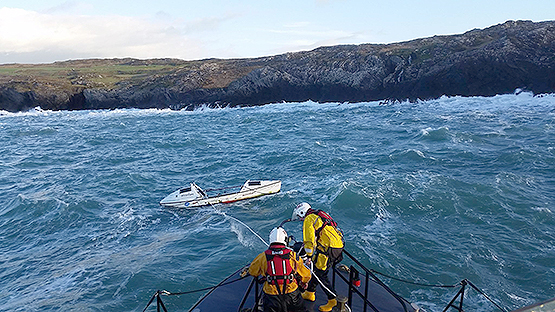Castletownbere RNLI has recovered a British adventurer’s transatlantic boat which was abandoned in a hurricane some 400 miles west of Portugal.
In what was their first call out of 2016, the volunteer lifeboat crew was requested to go the assistance of a boat yesterday afternoon (Tuesday 5 January) which was reported to be floating about 500m from the shore in Dunmanus Bay.
The lifeboat launched in Force Seven winds at 2.50pm and made its way amid a large sea swell to the scene, arriving at 3.27pm.
On arrival the crew noted that the boat Happy Socks was unmanned. The lifeboat crew proceeded to take the vessel under tow and bring her safely to Castletownbere.
Speaking following the call out, Paul Stevens, Castletownbere RNLI Lifeboat Press Officer said: ‘It transpired that this boat had been abandoned two months ago 400 miles west of Portugal by a lone oarswoman who was rowing from Cape Cod to London. She abandoned the boat in a hurricane and was picked up by a Canadian vessel.’
The British adventurer Sarah Outen MBE successfully completed her London2London expedition in November having set out from Tower Bridge in April 2011. Her goal via the world expedition was to row, bike and kayak the northern hemisphere, inspiring children and fundraising for charities. In her four and a half year adventure which saw her cover 25,000 miles, Sara overcame huge obstacles and endured extreme conditions in remote environments, including the hurricane on the Atlantic last year which forced a pre-emptive evacuation after 143 days at sea.
On hearing the good news about Happy Socks, Sarah phoned Castletownbere lifeboat station and tweeted last night: ‘Today I got that wonderful sort of news that makes your tummy turn and tears flow and rocks your happy socks off. Happy Socks is safe. We are making plans to go and retrieve her from SW Ireland where the @RNLI crew in Castletownbere found her today, just 500m from shore. A big and very grateful shoutout to the @RNLI crew at Castletownbere for bringing her in and letting us know. Go Happy Socks!’































































